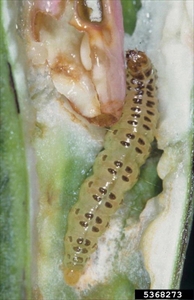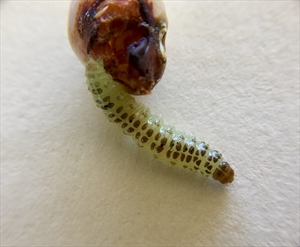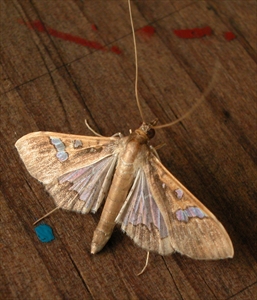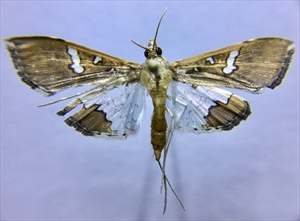Bean pod borer
Pacific Pests, Pathogens, Weeds & Pesticides - Online edition
Pacific Pests, Pathogens, Weeds & Pesticides
Bean pod borer (037)
Maruca vitrata; it used to be known as Maruca testulalis.
Asia, Africa, North, South and Central America, the Caribbean, Europe, Oceania. It is recorded from American Samoa, Australia, Fiji, French Polynesia, Guam, New Caledonia, Niue, Northern Mariana Islands, Papua New Guinea, Samoa, Solomon Islands, Tonga, and Vanuatu.
Many species of beans are hosts, including French bean, cowpeas, pigeon peas and yard long beans.
Eggs are pale cream, translucent (that is, they allow light through), and laid singly on the stems, young leaves, flowers and pods. They hatch and the caterpillars feed inside the flowers for about a week; then they move to the pods. They are pale cream, with two rows of dark dots on their backs (Photos 1&2). They grow to 18 mm before they exit the pods and pupate in the soil. The moths (Photos 3&4) have brown front wings, with white patches. The hind wings are mostly white with a brown border. They can be found under the lower leaves of the host plants.
Maruca vitrata is considered a major pest. The caterpillars do the damage. They bore into the pods and eat the seeds. There is also damage to the buds, flowers and leaves - they may be eaten and bound together by webs made by the caterpillars; however, damage to these parts is not large in comparison to that done to the pods.
Look for damaged flowers, and leaves and pods tied together by webs made by the caterpillars. Look for frass - faecal matter and chewed remains of the pods - around entry holes. Look for caterpillars inside the damaged pods: they are pale with two rows of black markings on their backs. The moth is brown with a white patch on the front wings.
NATURAL ENEMIES
Bracon parasitoids have been recorded in Fiji. Bracon cajani and Eiphosoma dentator were introduced into Fiji (1967-1978), but failed to establish. They lay their eggs in the caterpillars.
CULTURAL CONTROL
The bean pod borer is difficult to control, especially on yard long beans where flowering is over a long period of time.
Before planting:
- Do not plant next to already infested crops.
During growth:
- Look for early signs of webbing of the flowers by the caterpillars, and handpick them.
- Grow beans between rows of maize or sorghum; this method has been found to be effective in some African countries, although it is not a substitute for insecticides.
After planting:
- Collect and destroy crop debris after harvest.
RESISTANT VARIETIES
Seek advice from AVRDC (The World Vegetable Center) for differences between varieties of food legumes. Tolerant types of cowpea, pigeon pea and mung bean are reported. Check with local suppliers for availability.
CHEMICAL CONTROL
Pesticides are not recommended, because they are:
- Likely to kill natural enemies.
- Not very effective as the caterpillars are hidden for most of the time inside the pods.
- Expensive, and have to be used often.
- Continual use of one product may lead to the development of resistant populations of the moth.
The aim of the insecticide is to kill caterpillars as they move from the eggs in the flowers to the pods. If insecticides are necessary, do the following:
- Use plant-derived products, such as neem, derris, pyrethrum and chilli (with the addition of soap), or commercial products that contain disease-causing organisms, such as spinosad (Success) and Bt - Bacillus thuringiensis subspecies kurstaki (Dipel).
- Note, a variety of Derris, brought many years ago to Solomon Islands from Papua New Guinea, is effective as a spray. It contains rotenone, an insecticide, so it should be used with caution. There may be varieties of Derris (fish poisons) in your country that can be tried (see Fact Sheet no. 56).
- Synthetic pyrethroids are likely to be effective, but will also kill natural enemies.
____________________
When using a pesticide, always wear protective clothing and follow the instructions on the product label, such as dosage, timing of application, and pre-harvest interval. Recommendations will vary with the crop and system of cultivation. Expert advice on the most appropriate pesticides to use should always be sought from local agricultural authorities.
AUTHORS Grahame Jackson, Mani Mua & Helen Tsatsia
Information from Bean podborer (2018) Business Queensland. Queensland Government. (https://www.business.qld.gov.au/industries/farms-fishing-forestry/agriculture/crop-growing/pests-field-crops/bean-podborer); and CABI (2020) Maruca vitrata (lime bean pod borer). Crop Protection Compendium. (https://www.cabi.org/cpc/datasheet/32566). Photo 1 Shepard M, et al. Insects and their Natural Enemies Associated with Vegetables and Soybean in Southeast Asia, Bugwood.org. Photo 3 Gerald McCormack, Cook Islands Biodiversity Website: (http://cookislands.bishopmuseum.org/).
Produced with support from the Australian Centre for International Agricultural Research under project PC/2010/090: Strengthening integrated crop management research in the Pacific Islands in support of sustainable intensification of high-value crop production, implemented by the University of Queensland and the Secretariat of the Pacific Community.







